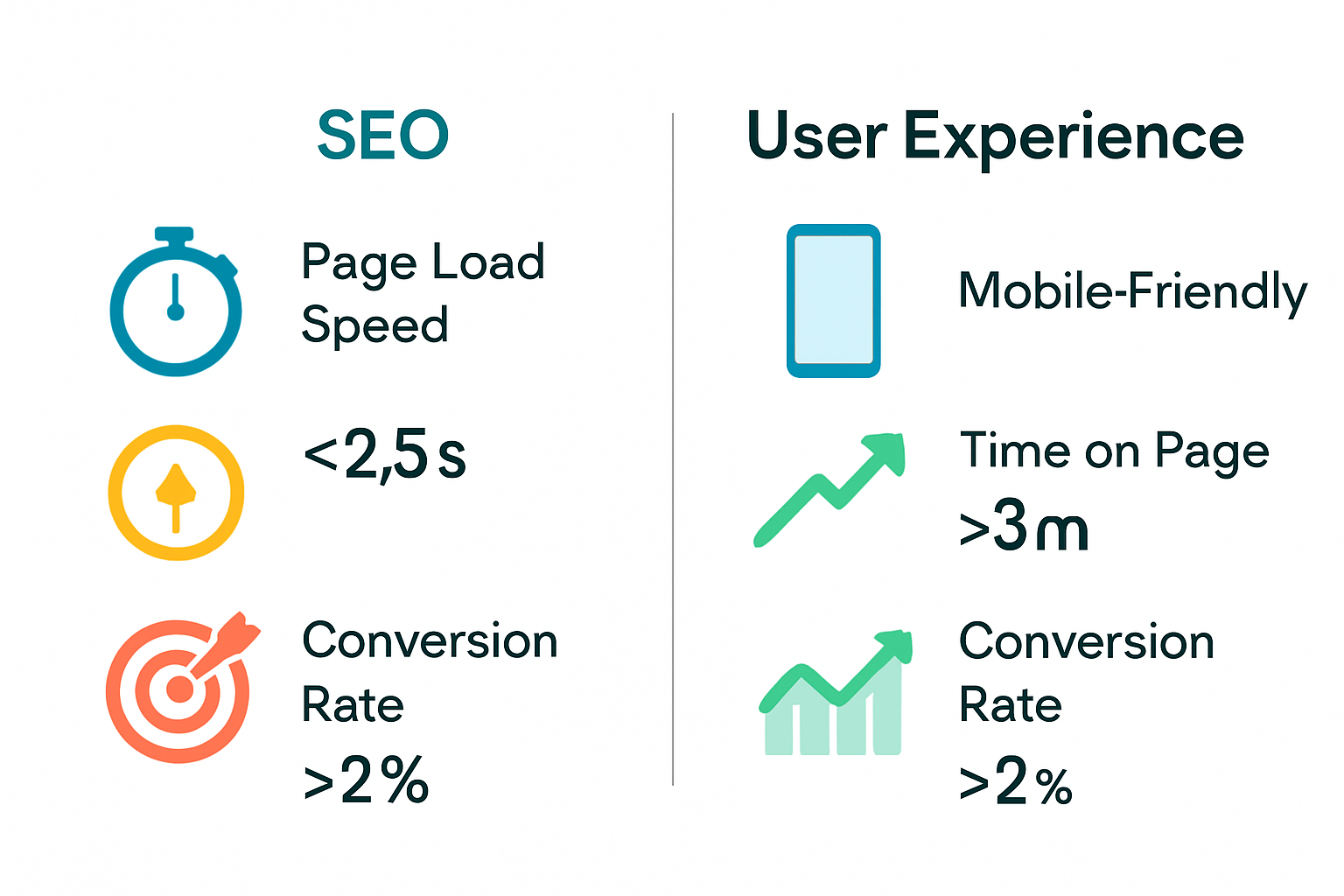SEO and user experience are quickly becoming inseparable in the world of digital strategy. You might think SEO is all about keyword research and rankings. Yet studies show that websites loading within two seconds enjoy dramatically lower bounce rates and higher retention. So while most chase after the latest SEO tricks, the real magic happens when every click actually delights your visitors. Curious how these two worlds create success together? You’re in the right place.
Table of Contents
- Understanding The Connection Between SEO And User Experience
- Key UX Elements That Impact SEO Rankings
- Best Practices For Integrating SEO And User Experience
- Measuring The Results Of SEO And User Experience Efforts
Quick Summary
| Takeaway | Explanation |
|---|---|
| SEO and UX are interdependent | Both fields must align to provide value and enhance user engagement effectively. |
| Focus on user experience signals | Metrics like bounce rate and load speed directly affect SEO rankings and user satisfaction. |
| Continuous improvement is vital | Regularly analyze user feedback and metrics for ongoing enhancements to both SEO and UX. |
| Content structure enhances engagement | Organized content with headings and clear hierarchy promotes usability and boosts search rankings. |
| Technical optimization is key | Factors like responsive design and fast load times play a crucial role in achieving higher search rankings. |
Understanding the Connection Between SEO and User Experience
Search engine optimization (SEO) and user experience are two interconnected disciplines that work together to create successful digital strategies. At their core, both aim to deliver value to users by providing relevant, accessible, and engaging content that meets specific needs and expectations.
The Symbiotic Relationship of Search and User Satisfaction
Search engines like Google have evolved to prioritize websites that offer exceptional user experiences. According to research from the University of Minnesota, implementing clear content and descriptive metadata not only improves search engine rankings but also enhances website accessibility. This means that SEO strategies are no longer just about keyword stuffing or technical manipulations but about creating genuine value for users.
The alignment between SEO and user experience is fundamentally about understanding user intent. When websites provide content that directly answers user questions, reduces navigation complexity, and offers intuitive design, they simultaneously improve their search rankings and user engagement. Research from a comprehensive digital dissertation highlights how website usability instruments directly correlate with user satisfaction and search performance.
Technical Optimization Meets User-Centric Design
Modern search algorithms analyze multiple user experience signals to determine website quality. Page load speed, mobile responsiveness, content readability, and interactive elements all contribute to both SEO performance and user satisfaction. Websites that optimize these technical aspects create a seamless experience that search engines recognize and reward.
Search engines have become sophisticated enough to measure user behavior metrics like bounce rate, time on page, and click-through rates. These metrics provide direct insights into how well a website meets user expectations. A site that quickly answers user queries, provides clear navigation, and offers valuable content will naturally rank higher because users find it more useful.
Learn more about advanced SEO ranking strategies that integrate user experience principles can help digital professionals create more effective websites that satisfy both search algorithms and human visitors.
By treating SEO and user experience as complementary rather than separate disciplines, businesses can create digital experiences that are not just discoverable but genuinely valuable to their target audience. The future of successful online presence lies in this holistic approach that prioritizes user needs while strategically aligning with search engine requirements.
Key UX Elements That Impact SEO Rankings
User experience (UX) elements play a critical role in determining search engine rankings, transforming how websites are evaluated and ranked. Modern search algorithms have become increasingly sophisticated in measuring user interaction and satisfaction signals.
Website Performance and Technical Optimization
Website performance metrics are fundamental to SEO rankings. Page loading speed directly influences user engagement and search engine perception. According to research from Google, websites that load within two seconds have significantly lower bounce rates and higher user retention. Mobile responsiveness is equally crucial, with search engines prioritizing sites that provide seamless experiences across different devices.
Key performance indicators that impact SEO include:
- Page Load Time: Faster websites receive higher ranking consideration
- Mobile Compatibility: Responsive design is now a critical ranking factor
- Technical Accessibility: Clean code structure and minimal server response times
Content Readability and User Engagement
Content quality and presentation significantly influence SEO performance. Search engines analyze how users interact with content through metrics like time on page, scroll depth, and interaction rates. Academic research from digital communication studies demonstrates that websites with clear, structured content and intuitive information architecture receive higher user engagement scores.
Effective content strategies involve:
- Clear Hierarchical Structure: Using headings, subheadings, and logical content flow
- Visual Comprehension: Incorporating images, infographics, and multimedia elements
- Readability Optimization: Writing in conversational language with appropriate complexity
Navigational Experience and User Journey
Website navigation directly impacts user experience and search engine rankings. Intuitive site structures that allow users to find information quickly are rewarded by search algorithms. Read more about advanced SEO ranking strategies that emphasize user-centered design principles.
Navigation elements that enhance SEO include:
- Clear Menu Structures: Logical categorization and easy-to-understand navigation
- Internal Linking: Connecting related content to improve user exploration
- Search Functionality: Enabling users to quickly find specific information
By focusing on these UX elements, websites can create holistic digital experiences that simultaneously satisfy user needs and search engine requirements. The future of SEO lies in understanding and implementing user-centric design strategies that prioritize human interaction and information accessibility.
To help clarify how key user experience (UX) elements directly impact SEO rankings, the following table summarizes the main factors and their respective influences:
| UX Element | Impact on SEO Rankings |
|---|---|
| Page Load Time | Faster load times reduce bounce rates and improve ranking consideration |
| Mobile Compatibility | Responsive design is prioritized by search engines |
| Technical Accessibility | Clean code and minimal server response aid rankings |
| Clear Content Structure | Organized headings boost usability and rankings |
| Visual Comprehension | Images/multimedia increase engagement and search appeal |
| Clear Menu and Navigation | Intuitive navigation is favored by algorithms |
| Internal Linking | Improved content exploration and SEO value |
| Search Functionality | Easier information access enhances user experience and rankings |
Best Practices for Integrating SEO and User Experience
Successfully integrating SEO and user experience requires a strategic approach that balances technical optimization with genuine user value. The goal is to create digital experiences that are both search engine friendly and genuinely helpful to visitors.
Content Strategy and Information Architecture
Effective content integration begins with understanding user intent and creating a clear, logical information structure. According to the U.S. Department of Energy’s communication standards, using clear page titles, concise summaries, and structured headings enhances both search engine visibility and user experience.
Key content integration strategies include:
- Semantic Keyword Usage: Incorporate relevant keywords naturally within high-quality, contextual content
- Comprehensive Coverage: Create in-depth content that thoroughly addresses user questions
- Logical Content Hierarchy: Organize information with clear headings and subheadings that guide user understanding
Technical Optimization and User-Centered Design
Carnegie Mellon University emphasizes that an SEO-friendly website must be well-structured, readable, and accessible. This means creating a seamless technical foundation that supports both search engine crawling and user navigation.
Critical technical considerations involve:
- Responsive Design: Ensuring consistent experience across all devices
- Page Speed Optimization: Minimizing load times and improving server response
- Intuitive Navigation: Creating clear, logical site structures that help users find information quickly
Continuous Improvement and User Feedback
Integrating SEO and user experience is an ongoing process of refinement. Learn more about advanced ranking strategies that help digital professionals stay ahead of evolving search algorithms.
Some key approaches to continuous improvement include:
- Analytics Monitoring: Regularly analyzing user behavior and search performance metrics
- User Feedback Collection: Implementing surveys and user testing to understand experience gaps
- Iterative Optimization: Making data-driven improvements based on user interactions

According to Michigan Technological University’s web guidelines, using structured content elements like headings, lists, and bullets not only improves SEO but significantly enhances overall usability.
Ultimately, the most successful digital strategies treat SEO and user experience as complementary rather than competing priorities. By focusing on creating genuine value for users while maintaining technical excellence, websites can achieve superior search rankings and user satisfaction simultaneously.
To guide ongoing improvement, here’s a checklist table of best practices for integrating SEO and user experience, drawn from strategies mentioned in this section:
| Integration Strategy | Description | Recommended Action |
|---|---|---|
| Content Structure | Use clear headings and organize information logically | Implement consistently |
| Semantic Keyword Usage | Incorporate relevant keywords naturally | Apply throughout content |
| Responsive Design | Ensure usability across all devices | Optimize for all screens |
| Page Speed Optimization | Minimize load times and server response | Regularly test and update |
| Analytics Monitoring | Analyze user and SEO metrics regularly | Ongoing review |
| User Feedback Collection | Gather direct input from users | Use surveys & testing |
| Iterative Optimization | Update based on data and user feedback | Continuous process |
Measuring the Results of SEO and User Experience Efforts
Measuring the combined impact of SEO and user experience requires a comprehensive approach that goes beyond traditional ranking metrics. Successful digital strategies demand nuanced, data-driven evaluation techniques that capture both technical performance and user satisfaction.
Key Performance Indicators and Analytical Metrics
Research from digital communication studies reveals that comprehensive SEO metrics extend far beyond simple ranking positions. Modern measurement approaches integrate multiple data points that reflect both search engine performance and user interaction.
Critical metrics for holistic evaluation include:

- Organic Traffic Quality: Analyzing visitor engagement beyond raw numbers
- Conversion Rates: Measuring how effectively website visitors complete desired actions
- Bounce Rate: Understanding user interaction and content relevance
- Time on Page: Evaluating content depth and user engagement
Advanced User Experience Assessment
Digital experience research introduces sophisticated evaluation frameworks like the Standardized User Experience Percentile Rank Questionnaire (SUPR-Q), which provides comprehensive insights into usability, trust, appearance, and user loyalty.
Comprehensive user experience measurement involves:
- Qualitative Feedback Collection: Direct user surveys and interviews
- Heatmap Analysis: Visual tracking of user interactions and site navigation
- Accessibility Compliance: Evaluating inclusivity and user experience across different devices
Integrated Performance Optimization
Learn more about comprehensive SEO audit techniques that help professionals develop data-driven optimization strategies.
Emerging search engine research demonstrates that modern evaluation models now incorporate sophisticated metrics like user attention, clicks, and satisfaction levels. These advanced approaches provide more nuanced understanding of website performance compared to traditional single-dimensional measurements.
Effective measurement strategies recognize that SEO and user experience are interconnected ecosystems. Successful digital professionals continuously monitor, analyze, and adapt their approaches based on comprehensive data insights. By treating measurement as an ongoing process of refinement, websites can create increasingly sophisticated, user-centric digital experiences that simultaneously satisfy search engine algorithms and human visitors.
Frequently Asked Questions
What is the relationship between SEO and user experience?
SEO and user experience (UX) are interdependent disciplines that focus on providing value to users by delivering relevant, accessible, and engaging content. A positive user experience can improve SEO rankings as search engines prioritize websites that satisfy user needs.
How can website performance impact SEO rankings?
Website performance, including page load speed and mobile responsiveness, significantly influences SEO rankings. Websites that load faster reduce bounce rates and improve user retention, helping them rank higher in search engine results.
What are some key user experience elements that affect SEO?
Key UX elements impacting SEO include page load time, content readability, navigational ease, clear content structure, and mobile compatibility. These components help enhance user engagement and, in turn, improve search rankings.
How can businesses improve both SEO and user experience simultaneously?
Businesses can enhance both SEO and user experience by implementing strategies like creating a well-structured content hierarchy, optimizing site navigation, continuously analyzing user feedback, and ensuring responsive design across devices.
Turn SEO and User Experience Insights Into Lasting Results
Have you ever put hours into blending SEO tactics with user experience improvements, only to find hidden keyword overlap sabotaging your efforts? Even the best strategy can suffer when keyword cannibalization causes technical optimization and content clarity to work against each other instead of together. The article highlighted how site structure, clear navigation, and user-focused content directly impact rankings and satisfaction. But if similar pages are competing for the same terms, your UX and SEO gains might never reach their full potential.
Ready to break out of the cycle and amplify both your visibility and usability? Let RankAligner Keyword Cannibalization Tool help you quickly find and fix competing keyword issues. This platform is trusted by leading SEO consultants and agencies for a reason. Visit https://rankaligner.com today and see how effortless it is to align your technical SEO with true user-first experiences. Take control now so every page and every click truly works for you.
Recommended
- Top SEO Ranking Factors 2025: A Guide for Consultants – Rank Aligner – Your Ultimate Keyword Cannibalization Problem Solver
- Search Engine History: Key Milestones and Impact in 2025 – Rank Aligner – Your Ultimate Keyword Cannibalization Problem Solver
- Semantic Search Explained: Boost SEO Results in 2025 – Rank Aligner – Your Ultimate Keyword Cannibalization Problem Solver
- How to Perform SEO Audit: Step-by-Step Guide for 2025 – Rank Aligner – Your Ultimate Keyword Cannibalization Problem Solver
- Why An SSL Certificate is Important for Client Trust and Google Rankings | Effortlessly Professional Websites
- What Is Operational Excellence? 2025 Guide for Agencies – Business Coach For Digital Marketing Companies, SEO, Social Media Agencies

